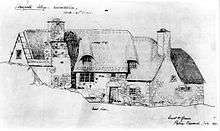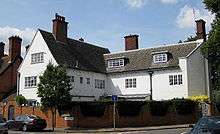Ernest Gimson
| Ernest Gimson | |
|---|---|
| Born |
21 December 1864 Leicester, England |
| Died |
12 August 1919 (aged 54) Sapperton, England |
| Occupation | Architect |

Ernest William Gimson (/ˈdʒɪmsən/; 21 December 1864 – 12 August 1919) was an English furniture designer and architect. Gimson was described by the art critic Nikolaus Pevsner as "the greatest of the English architect-designers".[1] Today his reputation is securely established as one of the most influential designers of the English Arts and Crafts movement in the late nineteenth and early twentieth centuries.
Early career
Ernest Gimson was born in Leicester, in the East Midlands of England, in 1864, the son of Josiah Gimson, engineer and iron founder, founder of Gimson and Company, owner of the Vulcan Works. Ernest was articled to the Leicester architect, Isaac Barradale, and worked at his offices on Grey Friars between 1881 and 1885.[2] Aged 19, he attended a lecture on 'Art and Socialism' at the Leicester Secular Society given by the leader of the Arts and Crafts revival in Victorian England, William Morris, and, greatly inspired, talked with him until two in the morning, after the lecture.[3]
Two years later, aged 21, Gimson had both architectural experience and a first class result from classes at Leicester School of Art. He moved to London to gain wider experience, and William Morris wrote him letters of recommendation. The first architectural practice he approached was John Dando Sedding, where he was taken on, and stayed for two years.[4] From Sedding, Gimson derived his interest in craft techniques, the stress on textures and surfaces, naturalistic detail of flowers, leaves and animals, always drawn from life, the close involvement of the architect in the simple processes of building and in the supervision of a team of craftsmen employed direct. Seddings offices were next door to the showrooms of Morris & Co., providing opportunity to see first hand the first flourishings of Arts and Crafts design. He met Ernest Barnsley at Sedding’s studio, and through him, Sidney Barnsley, a friendship that was to last the rest of his life.[5]
After a spell travelling in both Britain and Europe, Gimson settled in London again and in 1889 he joined Morris’s Society for the Protection of Ancient Buildings (SPAB). In 1890, he was a founder member of the short-lived furniture company, Kenton and Co., with Sidney Barnsley, Alfred Hoare Powell, W.R. Lethaby, Mervyn Macartney, Col. Mallet and Reginald Blomfield. Here they acted as designers rather than craftsmen and explored inventive ways of articulating traditional crafts, "the common facts of traditional building", as Philip Webb, "their particular prophet", had taught. Gimson had also, through the Art Workers' Guild, become interested in a more hands on approach to traditional crafts, and in 1890 spent time with Philip Clissett in Bosbury, Herefordshire, learning to make rush-seated ladderback chairs. He also began experimenting with plasterwork.[6]
Sapperton, Gloucestershire
Gimson and the Barnsley brothers moved to the rural region of the Cotswolds in Gloucestershire in 1893 "to live near to nature". They soon settled at Pinbury Park, near Sapperton, on the Cirencester estate, under the patronage of the Bathurst family. In 1900, he set up a small furniture workshop in Cirencester, moving to larger workshops at Daneway House, a small medieval manor house at Sapperton, where he stayed until his death in 1919. He strove to invigorate the village community and, encouraged by his success, planned to found a Utopian craft village. He concentrated on designing furniture, made by craftsmen, under his chief cabinet-maker, Peter van der Waals, whom he engaged in 1901.
Architectural work


His architectural commissions include
- Inglewood and The White House
- (1892 & 1898) in the prosperous Leicester suburb of Stoneygate;
- Lea, Stoneywell and Rockyfield Cottages
- in Ulverscroft, Charnwood Forest, Leicestershire (with Detmar Blow in 1897/9; Rockyfield 1909), all as summer retreats for his siblings. In February 2013 the National Trust had bought Stoneywell; it opened to the public in February 2015;[7][8]
- The Leasowes
- his own cottage, at Sapperton (1903, with a thatched roof, since burnt);
- alterations to Pinbury Park (with plasterwork) and Waterlane House
- (1908), both in Gloucestershire;
- Kelmscott
- cottages and the village hall (completed under Norman Jewson in 1933), Oxfordshire;
- Coxen
- at Budleigh Salterton, Devon, constructed in cob (rammed earth);
- Whaplode Church window
- Lincolnshire.
- Competition designs
- His competition 'Design for the Federal Capital of Australia' (1908) is an original project in town planning for the city which was to become Canberra. He also submitted a design for new offices for the Port of London Authority.[9]
- Bedales
- His last major project was the Memorial Library (1918–1919) built next to the 1911 Lupton Hall (also a Gimson design) at Bedales School, near Petersfield, Hampshire (where his brother was a teacher) (built at his request by Geoffrey Lupton under Sidney Barnsley's supervision and completed in 1921).
Legacy
The Sapperton workshop was closed after Gimson's death, but many of the craftsmen went with Peter van der Waals to his new premises in Chalford.
His architectural style is "solid and lasting as the pyramids… yet gracious and homelike" (H. Wilson, 1899). Lethaby described him as an idealist individualist: "Work not words, things not designs, life not rewards were his aims." Norman Jewson was his foremost student, who carried his design principles into the next generation and described his studio practices in his classic memoir By Chance I did Rove (1951).
Today his furniture and craft work is regarded as a supreme achievement of its period and is well represented in the principal collections of the decorative arts in Britain and the United States of America. Specialist collections of his work may be seen in England at the New Walk Museum, Leicester, and in Gloucestershire at the Cheltenham Art Gallery and Museum, Rodmarton Manor and Owlpen Manor.
Notes
- ↑ Pevsner, Nikolaus (1949). Pioneers of Modern Design. Penguin Books, London, 1960, p.152.
- ↑ Gill, Richard, 1985, The Book of Leicester, p.62. Barracuda Books, ISBN 0 86023 218 2
- ↑ Ernest's brother Sidney provides a vivid account of this meeting, in a 1932 account of the Leicester Secular Society, now in the Leicestershire Records Office and quoted at length in Comino (1980), p,13-15
- ↑ Comino 1980, p. 15.
- ↑ Comino 1980, p. 31.
- ↑ Comino 1980, p. 43.
- ↑ , Stoneywell blog, 2013.
- ↑ Tharp, Lars (Spring 2015). "Stoneywell's Story". National Trust Magazine: 53–7.
- ↑ leicester.gov.uk Gimson's architectural work Leicester Arts and Museums Service 2007. Accessed 14 October 2012
Sources
- Comino, Mary (1980). Gimson and the Barnsleys:'Wonderful furniture of a commonplace kind'. London: Evans Brothers Limited. ISBN 0237448955.
- Nicholas Mander, Owlpen Manor, Gloucestershire: a short history and guide (Owlpen Press, current edition, 2006) OCLC 57576417 ISBN 0-9546056-1-6
- W.R. Lethaby, F.L. Griggs & Alfred Powell, Ernest Gimson, his life and work (1924)
- Norman Jewson, By Chance I did Rove (Cirencester, 1951 (reprinted))
External links
| Wikimedia Commons has media related to Ernest Gimson. |
- Ernest Gimson
- Ernest Gimson and the Arts & Crafts Movement in Leicester
- Philip Clissett, Chairmaker 1817-1913
- blue Plaque for Gimson on the Belmont Hotel, Leicester
- Catalogue of photographs of furniture by Gimson, held at the DMU Archive